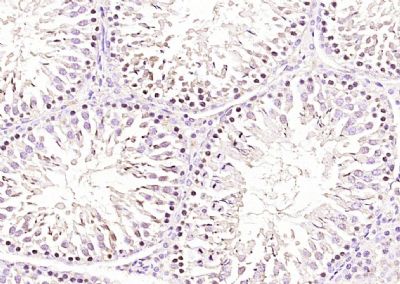RNF138 Polyclonal Antibody
Purified Rabbit Polyclonal Antibody (Pab)
- SPECIFICATION
- CITATIONS
- PROTOCOLS
- BACKGROUND

Application
| WB, IHC-P, IHC-F, IF, E |
|---|---|
| Primary Accession | Q8WVD3 |
| Reactivity | Rat, Pig, Dog, Bovine |
| Host | Rabbit |
| Clonality | Polyclonal |
| Calculated MW | 28 KDa |
| Physical State | Liquid |
| Immunogen | KLH conjugated synthetic peptide derived from human RNF138 |
| Epitope Specificity | 51-150/245 |
| Isotype | IgG |
| Purity | affinity purified by Protein A |
| Buffer | 0.01M TBS (pH7.4) with 1% BSA, 0.02% Proclin300 and 50% Glycerol. |
| SIMILARITY | Contains 1 RING-type zinc finger. |
| SUBUNIT | Interacts with NLK. |
| Post-translational modifications | Auto-ubiquitinated. |
| Important Note | This product as supplied is intended for research use only, not for use in human, therapeutic or diagnostic applications. |
| Background Descriptions | E3 ubiquitin-protein ligase. Together with NLK, involved in the ubiquitination and degradation of TCF/LEF. Also exhibits auto-ubiquitination activity in combination with UBE2K. May act as a negative regulator in the Wnt/beta-catenin-mediated signaling pathway. |
| Gene ID | 51444 |
|---|---|
| Other Names | E3 ubiquitin-protein ligase RNF138, 2.3.2.27, Nemo-like kinase-associated RING finger protein, NLK-associated RING finger protein, hNARF, RING finger protein 138, RING-type E3 ubiquitin transferase RNF138, RNF138 (HGNC:17765) |
| Dilution | WB=1:500-2000,IHC-P=1:100-500,IHC-F=1:100-500,IF=1:50-200,ELISA=1:5000-10000 |
| Storage | Store at -20 ℃ for one year. Avoid repeated freeze/thaw cycles. When reconstituted in sterile pH 7.4 0.01M PBS or diluent of antibody the antibody is stable for at least two weeks at 2-4 ℃. |
| Name | RNF138 (HGNC:17765) |
|---|---|
| Function | E3 ubiquitin-protein ligase involved in DNA damage response by promoting DNA resection and homologous recombination (PubMed:26502055, PubMed:26502057). Recruited to sites of double-strand breaks following DNA damage and specifically promotes double-strand break repair via homologous recombination (PubMed:26502055, PubMed:26502057). Two different, non-exclusive, mechanisms have been proposed. According to a report, regulates the choice of double-strand break repair by favoring homologous recombination over non-homologous end joining (NHEJ): acts by mediating ubiquitination of XRCC5/Ku80, leading to remove the Ku complex from DNA breaks, thereby promoting homologous recombination (PubMed:26502055). According to another report, cooperates with UBE2Ds E2 ubiquitin ligases (UBE2D1, UBE2D2, UBE2D3 or UBE2D4) to promote homologous recombination by mediating ubiquitination of RBBP8/CtIP (PubMed:26502057). Together with NLK, involved in the ubiquitination and degradation of TCF/LEF (PubMed:16714285). Also exhibits auto-ubiquitination activity in combination with UBE2K (PubMed:16714285). May act as a negative regulator in the Wnt/beta-catenin-mediated signaling pathway (PubMed:16714285). |
| Cellular Location | Chromosome. Note=Recruited at DNA damage sites (PubMed:26502055). Localizes to sites of double-strand break: localization to double-strand break sites is mediated by the zinc fingers (PubMed:26502055, PubMed:26502057) |

Thousands of laboratories across the world have published research that depended on the performance of antibodies from Abcepta to advance their research. Check out links to articles that cite our products in major peer-reviewed journals, organized by research category.
info@abcepta.com, and receive a free "I Love Antibodies" mug.
Provided below are standard protocols that you may find useful for product applications.
If you have used an Abcepta product and would like to share how it has performed, please click on the "Submit Review" button and provide the requested information. Our staff will examine and post your review and contact you if needed.
If you have any additional inquiries please email technical services at tech@abcepta.com.













 Foundational characteristics of cancer include proliferation, angiogenesis, migration, evasion of apoptosis, and cellular immortality. Find key markers for these cellular processes and antibodies to detect them.
Foundational characteristics of cancer include proliferation, angiogenesis, migration, evasion of apoptosis, and cellular immortality. Find key markers for these cellular processes and antibodies to detect them. The SUMOplot™ Analysis Program predicts and scores sumoylation sites in your protein. SUMOylation is a post-translational modification involved in various cellular processes, such as nuclear-cytosolic transport, transcriptional regulation, apoptosis, protein stability, response to stress, and progression through the cell cycle.
The SUMOplot™ Analysis Program predicts and scores sumoylation sites in your protein. SUMOylation is a post-translational modification involved in various cellular processes, such as nuclear-cytosolic transport, transcriptional regulation, apoptosis, protein stability, response to stress, and progression through the cell cycle. The Autophagy Receptor Motif Plotter predicts and scores autophagy receptor binding sites in your protein. Identifying proteins connected to this pathway is critical to understanding the role of autophagy in physiological as well as pathological processes such as development, differentiation, neurodegenerative diseases, stress, infection, and cancer.
The Autophagy Receptor Motif Plotter predicts and scores autophagy receptor binding sites in your protein. Identifying proteins connected to this pathway is critical to understanding the role of autophagy in physiological as well as pathological processes such as development, differentiation, neurodegenerative diseases, stress, infection, and cancer.


